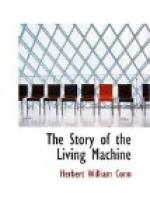==What is a Machine?==—Turning now to our more immediate subject of the accuracy of the statement that the body is a machine, we must first ask what is meant by a machine? A brief definition of a machine might be as follows: A machine is a piece of apparatus so designed that it can change one kind of energy into another for a definite purpose. Energy, as already noticed, is the power of doing work, and its ordinary active forms are heat, motion, electricity, light, etc.; but it may be in a passive or potential form, and in this form stored within a chemical molecule. These various forms of energy are readily convertible into each other; and any form of apparatus designed for the purpose of producing such a conversion is called a machine. A dynamo is thus a machine so adjusted that when mechanical motion is supplied to it the energy of motion is converted into electricity; while an electromotor, on the other hand, is a piece of apparatus so designed that when electricity is applied to it, it is converted into motion. A steam engine, again, is designed to convert potential or passive energy into active energy. Potential energy in the form of chemical composition (coal) is supplied to the engine, and this energy is first liberated in the active form of heat and then is converted into the motion of the great fly-wheel. In all these cases there is no energy or power created, for the machine must be always supplied with an amount of energy equal to that which it gives back in another form. Indeed, a larger amount of energy must be furnished the machine than is expected back, for there is always an actual loss of available energy. In the process of the conversion of one form of energy into another some of the energy, from friction or other cause, takes the form of heat, and is then radiated into space beyond our reach. It is, of course, not destroyed, for energy cannot be destroyed; but it has assumed a form called radiant heat, which is not available for our uses. A machine thus neither creates nor destroys energy. It receives it in one form and gives it back in another form, with an inevitable loss of a portion of the energy as radiant heat. With this understanding, we may now ask if the living body can be properly compared with a machine.
==A General Comparison of a Body and a Machine==.—That the living body exhibits the ordinary types of energy is of course clear enough when we remember that it is always in motion and is always radiating heat—two of the most common types of physical energy. That this energy is supplied to the body as it is to other machines, in the form of the energy of chemical composition, will also need no further proof when it is remembered that it is necessary to supply the body with appropriate food in order that it may do work. The food we eat, like coal, represents so much solar energy which is stored up by the agency of plant life, and the close comparison between feeding the body to enable it to work and feeding the engine to enable it to develop energy is so evident that it demands no further demonstration. The details of the problem may, however, present some difficulties.




